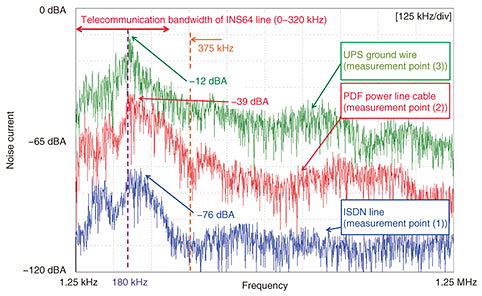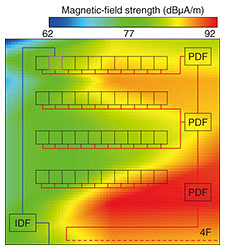 |
|||||||||||
|
|
|||||||||||
|
Practical Field Information about Telecommunication Technologies Vol. 18, No. 6, pp. 58–64, June 2020. https://doi.org/10.53829/ntr202006pf1 Case Studies of Telecommunication Failure Caused by Electromagnetic Noise from InvertersAbstractThis article introduces case studies of telecommunication failure caused by electromagnetic noise generated from inverters, which are increasingly being installed near telecommunication facilities. This is the fifty-eighth article in a series on telecommunication technologies. Keywords: switching noise, inverter, noise filter 1. IntroductionAn inverter is a device for converting direct current (DC) voltage into alternating current (AC) voltage and enables energy-efficient conversion by turning (switching) semiconductor switches in circuits on and off. However, it is known that high-level electromagnetic noise (switching noise) occurs during switching operation. Accompanying the spread of energy systems, such as photovoltaic power systems and storage batteries, an increasing number of inverters are being installed near telecommunication facilities. As a result, telecommunication failures, such as audible noise in analog telephones and asymmetric digital subscriber lines (ADSLs) going down (hereafter, link down), have occurred in various parts of Japan. This article introduces cases of telecommunication failure due to electromagnetic noise generated from inverters handled by the Technical Assistance and Support Center (TASC), NTT EAST. 2. Case 1: Link down of ADSL due to electromagnetic noise generated from photovoltaic power system2.1 Overview of telecommunication failureA customer who manages a photovoltaic power system reported that link down of their ADSL frequently occurs (Fig. 1). The local maintenance personnel took countermeasures such as replacing the ADSL modem; however, link down persisted, so TASC carried out an investigation of the cause of the telecommunication failure.
2.2 Details and results of investigationTo observe electromagnetic noise in the ADSL modem, an oscilloscope (Yokogawa DLM4058) was used to measure the voltages on the telecommunication cable of the ADSL modem (measurement point (1): L1 to the earth) and on the power line cable (measurement point (2): cold line to the earth). The results showed that voltages with a repetition frequency of 180 kHz existed on the telecommunication cable (around 90 Vp-p) and on the power line cable (around 180 Vp-p) (Fig. 2). The magnetic-field strength around the modem was measured using a spectrum analyzer (KEYSIGHT N9020A) and loop antenna (ETS-LINDGREN6512). The results showed that the largest electromagnetic noise (92 dBμA/m) occurred around the power conditioner (with a built-in inverter) of the photovoltaic power system over the entire ADSL telecommunication band with a peak at 180 kHz (Fig. 3).
2.3 Cause and countermeasureThe results of the investigation indicated that this telecommunication failure was caused by electromagnetic noise generated by the power conditioner of the photovoltaic power system being induced in the telecommunication cable (branch cable), which was laid out in parallel with the power line cable, and it affected the ADSL signal. As a countermeasure to this electromagnetic noise, a noise filter (V-MJS*1) was installed on the telecommunication cable (circuit-line side) of the ADSL modem. As a result of that countermeasure, the voltage generated on the telecommunication cable was reduced to 10 Vp-p and link down of the ADSL did not occur.
3. Case 2: Audible noise is heard during telephone calls due to electromagnetic noise generated by inverter for ventilation fans3.1 Overview of telecommunication failureA customer using a telephone fitted with a facsimile (hereafter simply referred to as the phone) reported that audible noise (a “bee...” sound) was always heard during telephone calls (Fig. 4). The local maintenance personnel replaced the wire with shielded one, but those measures did not resolve the telecommunication failure. Accordingly, TASC carried out an investigation of the cause of the failure.
3.2 Details and results of investigationTo observe electromagnetic noise entering the phone, an oscilloscope (Yokogawa DLM4058) was used to measure the voltages on the telecommunication cable (measurement point (1): L1 to the earth) and on the power line cable (measurement point (2): cold line to the earth) of the phone. The results showed that the voltages on the telecommunication and power line cables were around 4 and 150 Vp-p, respectively (Fig. 5). When the measured values were subjected to fast Fourier transform (FFT) processing, electromagnetic noise centered on 120 kHz was observed.
Additionally, the electromagnetic noise source was investigated by applying a noise propagation direction identification device (developed by TASC). The result of that investigation revealed that the inverter for the ventilation fan in cowshed B was the source of the electromagnetic noise. Accordingly, when the power of the inverter was turned off, the electromagnetic noise on the telecommunication and power line cables was reduced, and the audible noise on the phone line was eliminated. 3.3 Cause and countermeasureAccording to the results, it is revealed that this telecommunication failure was caused by the electromagnetic noise, which is generated from the inverter, invaded to the phone through its power line cable. As a countermeasure against this electromagnetic noise, the phone was replaced with one without a power line cable and a noise filter (DMJ-100k*1) was installed on the telecommunication cable of the phone. 4. Case 3: CRC error on ISDN line due to electromagnetic noise generated by UPS device4.1 Overview of telecommunication failureA customer using an integrated services digital network (ISDN) line at a datacenter reported that a cyclic redundancy check (CRC) error occurred (Fig. 6). The local maintenance personnel resolved the error by installing a noise filter (DMJ 6-2L*1) on the ISDN line, but the cause of the telecommunication failure was not determined, so an investigation was requested.
4.2 Details and results of investigationTo observe electromagnetic noise entering the customer server, an oscilloscope (Yokogawa DL9040) and current probe (EMCO 91550-2) were used to measure the currents on the ISDN line (measurement point (1)), on the power line cable under the PDF*2 (measurement point (2)), and on the ground wire of the uninterruptible power supply (UPS) (measurement point (3)). As a result of FFT processing on measured data, electromagnetic noise centered at 180 kHz was observed at all the measurement points; currents of –76 dBA (0.16 mA) and –39 dBA (11 mA) were observed at measurement points (1) and (2), respectively, and a largest current of –12 dBA (250 mA) was observed at measurement point (3) (Fig. 7).
A spectrum analyzer (Rohde & Schwarz PR100) and loop antenna (ETS-LINDGREN 6512) were used to measure the magnetic-field strength at 180 kHz inside the datacenter. The measurement results confirmed electromagnetic noise of up to 79 dBμA/m on the PDF side (Fig. 8). It was also observed that as for the power line cable side and ISDN-line side of the server, electromagnetic noise on the power line cable side was low and did not change even when the ISDN line was disconnected from the IDF*3 (measurement point (4)).
4.3 Cause and countermeasureAccording to the results, it is revealed that this telecommunication failure was caused by the electromagnetic noise, which is generated from the UPS, invaded to the DSU*4 through the power line cable, PDF, and IDF. As a countermeasure against this electromagnetic noise, a noise filter (DMJ 6-2L*1) was installed in the same manner as done by the local maintenance personnel.
5. Concluding remarksCases of telecommunication failure due to electromagnetic noise generated from inverters handled by TASC were introduced in this article. Although the electromagnetic noise troubles are completely solved by rejecting electromagnetic noise sources, it is possible to recover from a telecommunication failure by using a noise filter, as shown in the example cases. TASC developed a tool called an intelligent noise filter that can solve these electromagnetic noise faults without requiring specialist skill [1]. At the EMC Engineering Group in TASC, to reduce telecommunication failures caused by electromagnetic noise, radio, induction, lightning, etc., and to improve the reliability of telecommunication services, we will continue to actively engage in technical cooperation and development and disseminate our technologies through activities such as technology seminars. Reference
|
|||||||||||








